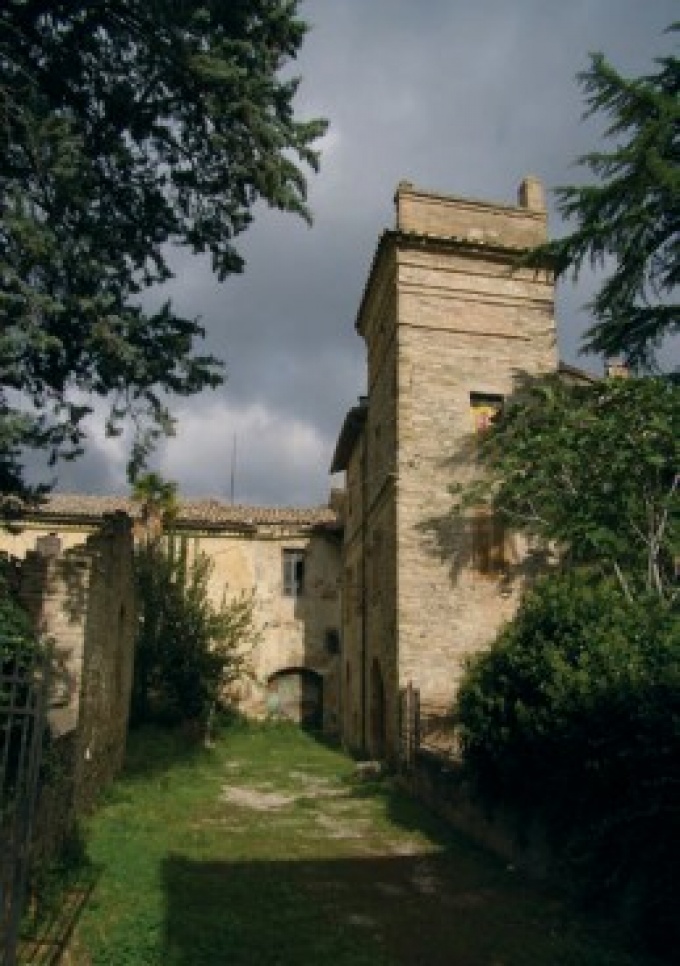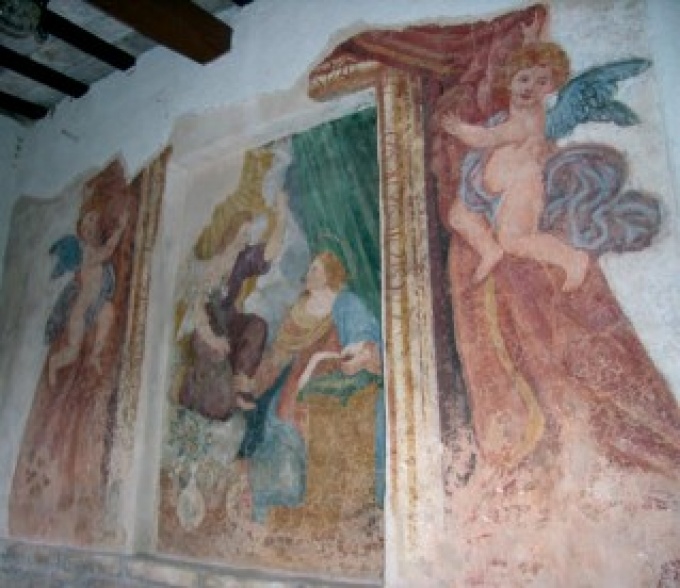After the capital, Cantalupo is the largest village in the Municipality of Bevagna. Located at an altitude of 204 metres above sea level, half way between Cannara and Bevagna, at the intersection between the torrent Attone (originally Lactone) and one of the paths of the Via Perugina, Cantalupo came to count 1,034 inhabitants in 1951, then dropping to 332 in 2001 and go up to around 500 in 2018.
The origin of his name, like the one of the other nine Italian villages named Cantalupo, is rather mysterious, and at least three hypotheses circulate on this name: the most fantastic wants that, in that area, when there was wind, they were heard howling wolves, and was therefore indicated as a place where the wolf sang (canta = sings; lupo = wolf). Another one refers to a predictive name, for which it could be called Castrum Lupi, from the name of Lupo (Wolf), descendant of the Antignano family. A third hypothesis, the most suggestive, considers the place as liminal of a vast territory dedicated to Janus (Torgiano, Limigiano, Giano dell’Umbria), whose name would be derived from Cantatus lucus, that is a sacred wood (to the same god) destined to transform from Cantaluco to Cantalupo.
Its first historical information dates to the Statute of Bevagna of the year 1500, which actually collects and rearranges provisions of much older statutes. Here Cantalupo is
named seven times as Castrum. But on the translation of the term it is good to underline that a castrum placed in height can certainly turn into a castellum (castle) as in the case of Castelbuono or consist of a turris (sighting tower) as in the case of Torre del Colle. A plain castrum, however, should be translated with terms such as “fortified camp” (not surprisingly, its origin is military) or, in Byzantine tradition, to “closed village”. In short, at first Cantalupo seems to have been a group of huts, arranged in a closed way close to a stream of water, and not a castle.
At the dawn of the 13th century it is probable that in its surroundings San Francesco (1181/82-1226) has passed through its movements between Assisi and Via Flaminia. The Franciscan hagiography (Tommaso from Celano, Fioretti) places in this regard in a locality near Cannara the episode of the “Preach to the Birds” by San Francesco. Today this episode is recalled by a small Holy Temple in Piandarca, just a short distance away from the Cantalupo.
As more accredited historians have observed, the reconstruction of that “Preach” is probably invented, while transit would not.
Between the 16th and 18th centuries the transformation of Cantalupo from castrum to villa (country village built around manor houses) took place. The refinement of its costumes is shown by two frescoes, dating back to the 16th and 17th century, located in the heart of the village. The first one reproduces an image of the Annunciation and is in the gallery of the house belonging today to Eulogio Franceschini. The second one, found in a niche inside an adjacent private house, shows in the center the Madonna and Child, San Sebastiano and San Rocco. The image of San Rocco, considered the protector of the pilgrims and the plagued, would suggest that in the area there was a monastic building or a little hospital although there are no documented traces. However, it is the pastoral visits of the six-eighteenth century bishops of Spoleto that attest to the growth of Cantalupo as a villa ever wider. From one of the numerous documents of the Diocesan Historical Archive of Spoleto, it is deduced that the “Villa Cantalupi” was equipped with a wheat dispenser and four churches: Beata Vergine dei Sette Dolori, Sant’ Angelo (San Michele Arcangelo), San Biagio and San Giovanni, with the addition of the church of Annunciazione in Montarone. The church of Beata Vergine dei Sette Dolori becomes in the course of time the church of Santa Maria Addolorata, while in the 20th century the remains of the church of San Biagio gradually disappeared. Moreover, a villa must be able to count on the presence of great owners. If we know about reconstructions of the state of the souls of the longest time that in Cantalupo live at least two rich families (Luccioli Falconieri and Torti);it is confirmed by the eighteenth-century land registry Avellani by a list of the numerous cultivable and cultivated lands owned by the Luccioli in a vast area of plain and hills around the country.
During the 20th century Cantalupo developed rapidly, reversing, by demographic weight and urban dimension, the relationship with Castelbuono, which is slowly but surely destined to lose inhabitants. The hilly settlement is becoming less and less functional, and this facilitates the greater comfort of the plain villages. The growth of Cantalupo is recorded in at least three spheres: in civil identity, political consciousness and infrastructural modernization.
Evidence of the first sphere is the commitment of the inhabitants to honour their own dead in the First World War, with a plaque, and, after the Second World War, with a monument to the fallen of both wars.
The liveliness of the political clashes is destined to awaken also around the musical passion that in the first half of the 20th century fully involves the popular classes. At least since 1902 there have been reports of the fanfare of Cantalupo, composed only of brasses, as well as of a music school particularly crowded until 1926. The fanfare is the pride of the village: it enlivens popular and religious festivals, participates in weddings and funerals, is invited to play in the neighbouring villages. In 1927, during the fascist period, the toy breaks. Perhaps because of political differences (some musicians had remained socialist while others had joined the Regime) or only for personal reasons, two fanfare is formed: the Quick Fanfare and the Terrible Fanfare, which practice in two different cellars. But after a suspension of the musical institution in Cantalupo, in 1928 the reunified Fanfare, transformed into Banda, will resume the activity continuing to survive between ups and downs until 1958.
But it is on the level of the sense of belonging and social cohesion that the spirit of Cantalupo resists over time. In 1978 the Pro Loco Cantalupo-Castelbuono was established to promote the environmental and artistic beauty of the territory and to defend and propose popular traditions. From the beginning, his best-known initiative is the Sagra della Lumaca, born from the commitment of two passionate inhabitants, Giuseppe (known as Peppe) Pensa and Leonello Tordoni, and from the generous and voluntary effort of many women, among which Giacomina Tamburo. It takes place in the last week of August (from 2016 it is also proposed as “Lumache in Inverno”) in the large Centropolivalente of the village. As the Pro Loco website says, “Sagra della Lumaca has become a gastronomic and cultural reference point for the region and it is one of its most interesting manifestations thanks to the ability to convey the values of the Umbrian tradition. From the few kilos of snails collected by the inhabitants in the countryside of Cantalupo, today, during the Festival, more than 80 quintals of snails are cooked. At the Sagra della Lumaca more than 150 volunteers from the village and neighbouring ones work and has a turnout of more than ten thousand people. Since 1995 Cantalupo is one of the fifteen cities of the snail, scattered throughout Italy, from Sicily to Piedmont, which have as reference point the National Association of Heliciculture”.
The Pro Loco, however, does not limit itself to this. In 2010 it becomes a supporter of the birth of the Park of the Sculpture of Castelbuono, which starts under the direction of Paolo Massei. Since then it celebrates every year his installations in the framework of the Week of Culture of Peace held in Castelbuono between 25 April and 1st May.
Some members of Pro Loco (first of all Domenico lanari) and other inhabitants also founded in 1988 the “Centro di Solidarietà Ape”. The Centre, which is run by volunteers and has about 700 members divided into 280 families. It is self-financing and raises funds with the aim of freely helping all those who need health facilities in case of highly disabling diseases.
For Bevagna inhabitants, Umbrian people and other-origins gourmets, the name Cantalupo remains today associated essentially with the Sagra della Lumaca. There is some truth in this perception, but that is not all. In mid-August each year, a week before the festival starts, many Cantalupo inhabitants (about 200 residents and exiles) meet at Centro Polivalente to spend time and have lunch together. More than thinking of wolves and snails, they are there above all to celebrate– in a society dispersed in assonances and affections like that of today; an ancient and renewed sense of belonging. A collective identity that may seem even improbable to those who are not from Cantalupo.
Segatori, GRANDE DIZIONARIO DI BEVAGNA, Vol 11 – pp : 8-9










